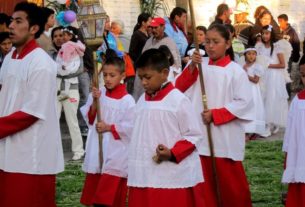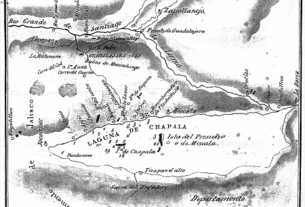This seems like a good time of year to talk about the culinary specialties of Guerrero, the Mexican state whose coastline is home to some of the country’s most popular winter resorts, including Acapulco and Zihuatenejo. Chilly northerners flock to their beaches to enjoy sunbathing, water sports, and the area’s abundant seafood.
But although the beaches are better known to visitors, Guerrero also has mountains and plains, where the food is quite distinct from that of the coast. In fact, Guerrero is considered to have seven different regions, as is the case with much of southern Mexico, where the mountains create boundaries between the various microclimates.
Because the inhabitants of Guerrero still subsist on the different flora and fauna found in these microclimates, their gastronomy remains largely true to its pre-Hispanic roots. Although one of Mexico’s poorest states, it is rich in culinary resources, including the fish and shellfish of its Pacific waters and inland rivers, the wild game of the mountains, and the tropical fruit found throughout the state.
Guerrero’s coastline is so long that it is divided into two regions, the Costa Chica, which starts just south of Acapulco and continues east to the Oaxacan coast, and the Costa Grande, which is all of the coastline northwest of Acapulco.
The Costa Chica is inhabited by the indigenous Amuzgos and coastal Mixtecs, as well as mestizos and descendents of former slaves from West Africa. Several of the rivers that originate in Guerrero’s mountain region flow down into the Pacific along the Costa Chica, making it one of the more humid of Mexico’s tropical areas. Mangos, coconuts, watermelon and sesame are all raised here, along with the ubiquitous corn. Although not as well known as the major resort areas, both Playa Ventura and Punta Maldonado offer beautiful beaches and abundant seafood. Caldo largo, a fish stew, is probably the dish most widely associated with the Costa Chica, where a variety of seafood cocktails are also quite common.
Along the Costa Grande, the resort towns of Ixtapa, Zihuatenejo, Troncones and Barra de Potosí all offer innovative cuisine, in addition to the classic shrimp and crab soups, and caldo de cuatete, made with the area’s blue sea catfish. Talented chefs, in competition for tourist business, are constantly inventing new combinations of local ingredients, such as fresh tuna with nopales, shrimp sautéed with tequila, and fish served with sauces of mango and tamarind. And all along Guerrero’s coast, white rice, called morisqueta, is the standard accompaniment to seafood.
Acapulco itself is considered by guerrerenses to be its own region, possibly because half the population of the entire state lives there. Famous for its ceviche, the Acapulco region includes Barra Vieja, a long sandbar that extends eastward from Acapulco between the Pacific Ocean and Laguna Tres Palos. This is where the Papagayo River flows into the ocean, and the river shrimp with garlic and chile sauce is a local specialty, as is pescado a la talla, grilled fish that has been bathed in a chile-based sauce before being put on the coals.
In the same region, six miles north of Acapulco, is Pie de la Cuesta, another sandbar, this one between the ocean and the Laguna Coyuca. Restaurants along the beach feature freshly caught snooker, mullet, tilapia, snapper, catfish, freshwater shrimp and crab, as well as guinatán, dried fish cooked in coconut milk. (The Philippines also have several dishes called guinatn, cooked the same way. This is not surprising, since the Spanish fleet of Manila galleons that went to the Far East was built and launched from Mexico’s Pacific coast, creating yet another culinary exchange.)
Heading due north from the Costa Grande, one comes to the region known as the Tierra Caliente, the northwestern part of Guerrero that borders on Michoacan. A major supplier of beans, the Tierra Caliente also produces lemons, limes, oranges, mangos, guava, tamarind, watermelon and cantaloupe. Here barbacoa — barbequed goat — is a favorite, along with the pork infused beans called frijoles puercos. A popular regional breakfast dish is aporreado, consisting of cecina (dried, salted meat) cooked with eggs and chiles.
The people of this region have traditionally enriched their diet with maguey worms, grasshoppers, and small game birds, especially the quail-like güilotas, in addition to the indigenous armadillo, rabbit, iguana and badger. With typical culinary ingenuity, the cooks of this region have made the wild game dishes not just palatable, but delicious. Rabbit in garlic sauce, iguana in green pipian, quail in a garlic and chile sauce and badger in red sauce are all local specialties. Arcelia, a municipality poetically called by its inhabitants “the sun’s beautiful bride.” is known for its fine cooks, local cheeses and flavorful wild herbs called chichihuates, used to add flavor to just about anything that can be rolled in a tortilla.
To the east of the Tierra Caliente lies the Norte region, bordering on the State of Mexico and Morelos. Its most important city is Taxco, known worldwide for its silver, and also for its most famous edible, the stinkbugs called jumiles. Popular with tourists, jumiles are also nutritious, being rich in iodine, riboflavin and niacin. They even have their own fiesta, the Día de Jumiles, held on the first Monday after Day of the Dead. At this time, which is the beginning of jumil season, Taxco’s residents flock to a wooded mountain called the Cerro Huixteco, to hunt for jumiles and crown a Jumil Queen. The jumiles are then used to make a salsa with chiles, onion and garlic, or to fill tacos.
Other popular items in the Norte region are pigeon, rabbit and iguana, usually prepared in tamales or in mole. Fiambre, a dish of pork, chicken, beef, jalapenos, raisins, almonds and olives, is one of the few dishes that reflects more of a Spanish than an indigenous influence. Tlaxcales, triangular tortillas with cheese, are a popular snack food.
The easternmost part of Guerrero is a region called La Montaña, whose inhabitants are mestizos, Tlapanecos and some Mixtecs. The name Tlapaneco is derived from their place of origin, Tlapo. Although this wooded region, where the people cook nearly all food on woodstoves, has several isolated villages, the Voz de la Montaña (Voice of the Mountain) radio station keeps them informed of events in other villages. Ceremonial and ritual events are numerous, since this has been the center of Tlapaneco culture since pre-Hispanic times. The great quantity of wild herbs and mushrooms that grow here form an important part of the local diet, as do possums, rabbits, armadillos, snakes, squirrels and various wild birds.
In addition to the wild game and herbs, cultivated crops are important as sources of nutrition and income. The most important crops are corn, beans, squash, coffee, guavas and, in the lower region, jamaica, the red hibiscus flower used so extensively in Mexico to make the flavored drink agua de jamaica. For these ancient people, their many fiestas and ceremonial meals are entwined with their devotion to the water god Totonásha and the earth goddess Sabenásha.
Moving inland to Centro region, one comes to the state capital, Chilpancingo. This is one of those towns where it is nearly impossible to find bad street food. Vegetable quesadillas, filled with squash, corn, squash blossoms and epazote; sweet, fresh corn tamales known as elotamales; wonderfully spiced pork tamales, fragrant with allspice and cloves; sweet gorditas flavored with cinnamon and piloncillo are only a few of the corn dough based creations upon which to feast.
Being the hub of the region, Chilpancingo is the gastronomic as well as political capital. Pozole, the most well known food throughout the state, is a major attraction here, with people flocking to its pozolerías for the traditional Thursday night pozole supper. (For a description of pozole and its traditions, see Warm up the Winter with Pozole, where recipes for both Guerrero-style green and white pozoles are given.)
Another prominent dish of the Centro region is chilatequile, which is said to date back to pre-Hispanic offerings to the sol de oriente, the Eastern sun. This ritual stew always contained tomato, epazote and, most importantly, dried red chile to give it the sacred red color of the sun. Today, other than the beef introduced by the Europeans, it still contains herbs, squash, chayotes, corn and guajillo chiles.
For dessert, there are torrejas, somewhat akin to strips of French toast, dulce de camote, made with yams, and a variety of nieves — ice creams and ices made with tropical fruits.
To accompany all this food, the local herb toronjil, popular throughout the country as a digestive, is drunk as a tea. Other, more potent beverages popular in Guerrero are tuba, fermented from coconuts, and sangre de Baco, literally Bacchus’ Blood, a fermented crushed grape drink. A more recent invention is something called a “Berta”, made with tequila, honey, lime juice and mineral water.
It sounds like those not planning to go to Guerrero’s beaches this winter could probably stave off cold symptoms by drinking a “Berta” and trying a few of these regional recipes.
Caldo Largo de Pescado: Fish Stew from the Costa Chica
Camarones Estilo Barra Vieja: Barra Vieja Style Shrimp
Pescado a la Talla: Guerrero Style Grilled Fish
Güilotas de Tierra Caliente: Braised Quail with Garlic and Chile


